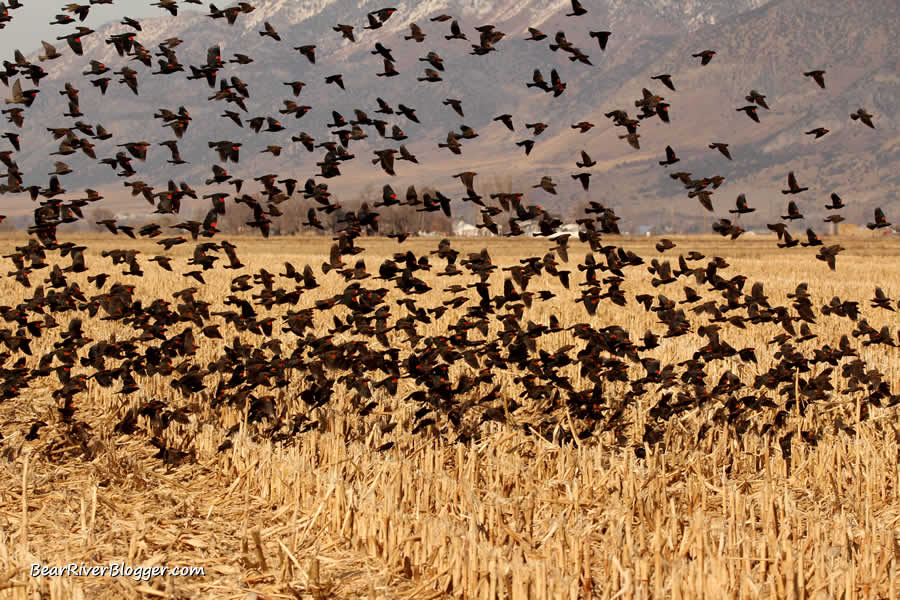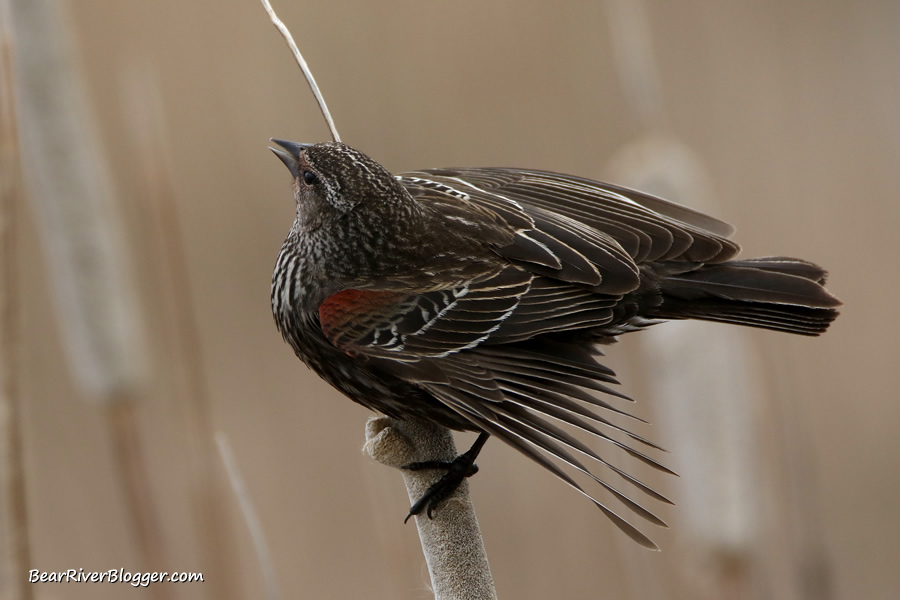When I first started photographing birds on the Bear River Migratory Bird Refuge auto tour route many years ago two particular species stood out above all the rest and immediately grabbed my attention from the very first day, one was, of course, the quirky yet beautiful American avocet with the other being the melodic male red-winged blackbird.
As I drove around the auto loop that day male red-winged blackbirds were commonly perched along the gravel road in nearby patches of cattails and I can still remember the very first time I saw and heard one display and sing.
Saying the melodic vocalization and brightly colored plumage patches left me quite enchanted would be a gross understatement, to say the least.
Fast-forward to last week when I photographed one of the blackbird images for today’s blog post and I can honestly declare my interest in the red-winged blackbird has not waned a single bit in all those years and, honestly, I doubt it ever will.
Red-winged blackbirds have one of the sweetest, most melodic songs in nature and that, coupled with their bright red and yellow scapulars on display during breeding season, are two of the many reasons why I love watching and listening to the red-winged blackbird sing anytime I am on the bird refuge auto loop.
In fact, it doesn’t even have to be on the bird refuge, per se, as it is quite common for me to go out on a daily walk just around my house this time of year and find male red-winged blackbirds perched atop a small patch of cattails in the roadside borrow pit singing his heart out in hopes of attracting a mate to his small piece of declared territory.
Over the years, I have learned a couple things about red-winged blackbirds from countless hours watching, photographing, and even reading about them so, as a result, here are five interesting facts about the red-winged blackbird I hope you will find just as intriguing and enlightening as I do.
Red-winged Blackbirds Sing To Declare Their Territory

Visit almost any wetland during spring in the United States and you have a great chance of finding male red-winged blackbirds perched atop cattails singing and displaying their bright red and yellow scapulars to attract females to breed with and to declare their nesting territory against rival males.
In fact, if you stop and watch blackbirds during the breeding season it usually won’t be long before you observe male red-winged blackbirds becoming quite aggressive towards other males, commonly harassing and fiercely chasing rival males for long distances until they are out of their declared nesting territories.
Other times you can sit and watch rival males close to one another put on a vocal and display battle where they try to outdo one another for the attention of any nearby females, calling more frequently and more distinctly showing their colorful wing plumage.
Although during winter it is quite uncommon, male red-winged blackbirds can occasionally be heard singing year-round but it is during spring and early summer when they are noticeably the most vocal by far.
Red-winged Blackbirds Will Eat Phragmites Seeds During The Winter

This one caught me by surprise when a couple months ago I watched and photographed numerous red-winged blackbirds eating the seeds from a thick patch of phragmites.
It wasn’t a one-time-only event either, mind you, as I have seen this behavior numerous times since then this past winter on the Bear River Migratory Bird Refuge auto tour route so I am convinced blackbirds have adapted somewhat to eating the seeds of the phragmites plant when necessary.
The reason why this is so intriguing is phragmites is a highly invasive, non-native grass that has been plaguing wetlands all across Utah as well as most of the United States for decades now, choking out their native vegetation in the process, and has been deemed quite useless when it comes to food and nesting material for birds.
Red-winged Blackbirds Oftentimes Congregate In Large Flocks During Winter

It’s not uncommon during wintertime for red-winged blackbirds to congregate in very large flocks and leave the wetlands for a period to feed in nearby agricultural fields that offer waste grains of corn and wheat.
Sometimes these flocks of wandering red-winged blackbirds are comprised of hundreds of individual birds and can be seen flying in tight unison as they scavenge food from harvested and even unharvested corn fields during the winter months just west of the bird refuge visitors center on Forest Street.
Red-winged blackbirds can still be found on the Bear River Migratory Bird Refuge auto tour route during winter feeding on cattail seeds and cocklebur, mind you, but not nearly in the numbers as during the spring and summer months when those that left the refuge during winter return to breed, feeding mainly on insects for the summer.
Red-winged Blackbirds Are Very Aggressive In Defending Their Nests

Red-winged blackbirds, both males and females, are very aggressive during nesting season to protect and defend their nest and young from predators and even people, anything they feel is a threat to their babies.
Hawks and ravens, for example, are very commonly chased and harassed by red-winged blackbirds when they get too close to the nest.
In fact, similar to the picture above images are floating around the internet depicting red-winged blackbirds riding on the back of a hawk but, honestly, nothing could be further from the truth.
In such cases, images similar to the one above I photographed last summer at Farmington Bay are the exact moment when the blackbird is pestering the hawk as best it can to get the raptor to leave the area and not try to casually ride its back like some want you to believe.
Red-winged blackbirds will chase away much larger birds, hawks included, if they feel their nest is threatened but sometimes, as in the case with certain misleading images posted on the internet, things shown through photography aren’t always as they actually are.
Female Red-winged Blackbirds Will Vocalize And Display At Times

One of the most curious red-winged blackbird behaviors I have ever seen is the female blackbird displaying and vocalizing to some degree.
I don’t see it very often but I have seen it enough times to safely say there are times when female red-winged blackbirds will call and display around the nest site for some reason.
It’s quite different than the male’s vocalization and display, not nearly as dramatic or as long or loud, but it definitely is noticeable when it happens and I was able to photograph it once, shown in the image above, while on the Bear River Bird Migratory Bird Refuge several years ago.
Subscribe To And Follow Bear River Blogger
If you are an avid birdwatcher or maybe just a casual nature enthusiast I offer you to head on over to our subscribe page and sign up for email notifications for future blog posts where we share our love and enthusiasm for nature, birds, butterflies, and anything else we can put in front of our camera lens to share with you here on our website.
For those of you who utilize the technology of social media, we have also started a Bear River Blogger Facebook page you can follow where we post updates and images about the famous Bear River Migratory Bird Refuge auto tour route, as well as other natural places of interest, that are too small for a blog post here on this website.
(Male Red-winged Blackbird Calling. For short nature photography tips and interesting stories about the natural world around us, subscribe to our Bear River Blogger channel on YouTube for videos and updates from our travels while out in nature, both on and off of the famed Bear River Migratory Bird Refuge.)




